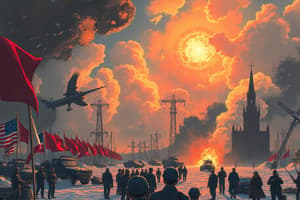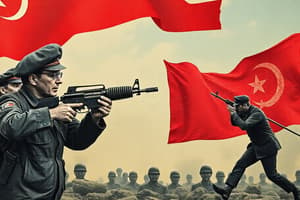Podcast
Questions and Answers
Which of the following was NOT a feature of the Cold War?
Which of the following was NOT a feature of the Cold War?
- Direct military confrontation between the US and USSR (correct)
- Espionage activities
- Proxy wars
- Economic competition
What was the primary purpose of the Warsaw Pact?
What was the primary purpose of the Warsaw Pact?
- To facilitate cultural exchange between the Soviet Union and its allies.
- To establish a unified political system for Eastern Europe.
- To provide a counterbalance to the North Atlantic Treaty Organization (NATO). (correct)
- To promote economic cooperation among Eastern Bloc nations.
Which of the following best describes the "Iron Curtain" as used by Winston Churchill?
Which of the following best describes the "Iron Curtain" as used by Winston Churchill?
- A physical barrier separating Eastern and Western Europe.
- An economic blockade imposed by the Soviet Union on Western Europe.
- A military alliance formed by the Soviet Union and its allies.
- A metaphorical division between communist and capitalist ideologies. (correct)
What major event symbolized the division and tensions of the Cold War?
What major event symbolized the division and tensions of the Cold War?
The Cold War was a period of intense rivalry between the US and the USSR. Which of the following was NOT a major factor contributing to this rivalry?
The Cold War was a period of intense rivalry between the US and the USSR. Which of the following was NOT a major factor contributing to this rivalry?
What does the term "Cold War" refer to?
What does the term "Cold War" refer to?
Which of these factors fueled the Cold War?
Which of these factors fueled the Cold War?
What was the impact of the Cold War on Europe?
What was the impact of the Cold War on Europe?
What was the main reason the Cold War did not escalate into a full-scale military conflict?
What was the main reason the Cold War did not escalate into a full-scale military conflict?
What was distinctive of the political systems in the Eastern Bloc?
What was distinctive of the political systems in the Eastern Bloc?
Which of these countries was NOT a member of the Warsaw Pact?
Which of these countries was NOT a member of the Warsaw Pact?
Which of the following events marked the symbolic beginning of the "Space Race" between the US and the USSR?
Which of the following events marked the symbolic beginning of the "Space Race" between the US and the USSR?
What was the purpose of the North Atlantic Treaty Organization (NATO)?
What was the purpose of the North Atlantic Treaty Organization (NATO)?
Which of these countries is a member of both the Warsaw Pact and NATO?
Which of these countries is a member of both the Warsaw Pact and NATO?
Why was the Cold War described as "cold"?
Why was the Cold War described as "cold"?
Which of the following was NOT a key characteristic of the Cold War?
Which of the following was NOT a key characteristic of the Cold War?
What was the main factor driving the division of Europe following World War II?
What was the main factor driving the division of Europe following World War II?
Which of the following statements BEST describes the impact of the Cold War on Europe?
Which of the following statements BEST describes the impact of the Cold War on Europe?
Which of the following is NOT a key concept associated with the Cold War?
Which of the following is NOT a key concept associated with the Cold War?
What did the term "Iron Curtain" symbolize during the Cold War?
What did the term "Iron Curtain" symbolize during the Cold War?
How did NATO and the Warsaw Pact contribute to Cold War tensions?
How did NATO and the Warsaw Pact contribute to Cold War tensions?
What is the best definition of a "centrally planned economy"?
What is the best definition of a "centrally planned economy"?
What is the significance of the US and the Soviet Union emerging as superpowers following World War II?
What is the significance of the US and the Soviet Union emerging as superpowers following World War II?
Flashcards
Cold War
Cold War
A geopolitical rivalry between the US and USSR from post-WWII to the 1990s.
Iron Curtain
Iron Curtain
The term used to describe the division of Europe during the Cold War.
NATO
NATO
A military alliance formed by Western countries for collective defense against aggression.
Warsaw Pact
Warsaw Pact
Signup and view all the flashcards
Nuclear Arms Race
Nuclear Arms Race
Signup and view all the flashcards
Pluralistic State
Pluralistic State
Signup and view all the flashcards
Totalitarian State
Totalitarian State
Signup and view all the flashcards
Planned Economy
Planned Economy
Signup and view all the flashcards
Capitalist Economy
Capitalist Economy
Signup and view all the flashcards
Military Alliances in Europe
Military Alliances in Europe
Signup and view all the flashcards
Geopolitical Tension
Geopolitical Tension
Signup and view all the flashcards
Factors of Totalitarianism
Factors of Totalitarianism
Signup and view all the flashcards
Centrally Planned Economy
Centrally Planned Economy
Signup and view all the flashcards
Superpower
Superpower
Signup and view all the flashcards
Expansion of Influence
Expansion of Influence
Signup and view all the flashcards
Study Notes
Cold War - USA and Soviet Union
- The Cold War was a period of geopolitical tension between the US and the Soviet Union after World War II
- It was characterized by ideological conflict (capitalism vs communism)
- The US sought to contain the spread of communism, while the Soviet Union aimed to spread its influence.
- The two superpowers engaged in proxy wars and arms races, creating a climate of fear and distrust.
US and Soviet spheres of influence
-
Post-WWII, both the US and the Soviet Union exerted influence on European countries.
-
Countries aligned with the US (NATO) experienced economic and political developments
-
The Soviet Union (Warsaw Pact) controlled areas, also having economic and political developments.
-
The US & Soviet Union dominated geopolitics and economics
-
US promoted capitalism and democracy, while the Soviet Union promoted communism
-
This rivalry created tensions, proxy wars, and an arms race.
-
Political and economic instability and conflict were present in Europe during the Cold War.
Characteristics of the Cold War
- Proxy wars: Conflicts where the superpowers supported opposing sides, but without engaging directly
- Arms race: A competition between the superpowers to develop advanced weaponry, and to deter each other.
- Propaganda: Both sides used propaganda to promote their ideology and criticize the other's.
- Ideological conflict: The fundamental difference in political and economic systems between the two superpowers.
- Espionage: Both sides engaged in covert operations to gather intelligence, and disrupt each other's activities.
Impact on Europe
- The Cold War divided Europe into two opposing blocs: NATO and the Warsaw Pact.
- The division influenced political and economic structures
- The division caused physical and mental anxieties
- This division created social, political, and economic divides in Europe.
Studying That Suits You
Use AI to generate personalized quizzes and flashcards to suit your learning preferences.




